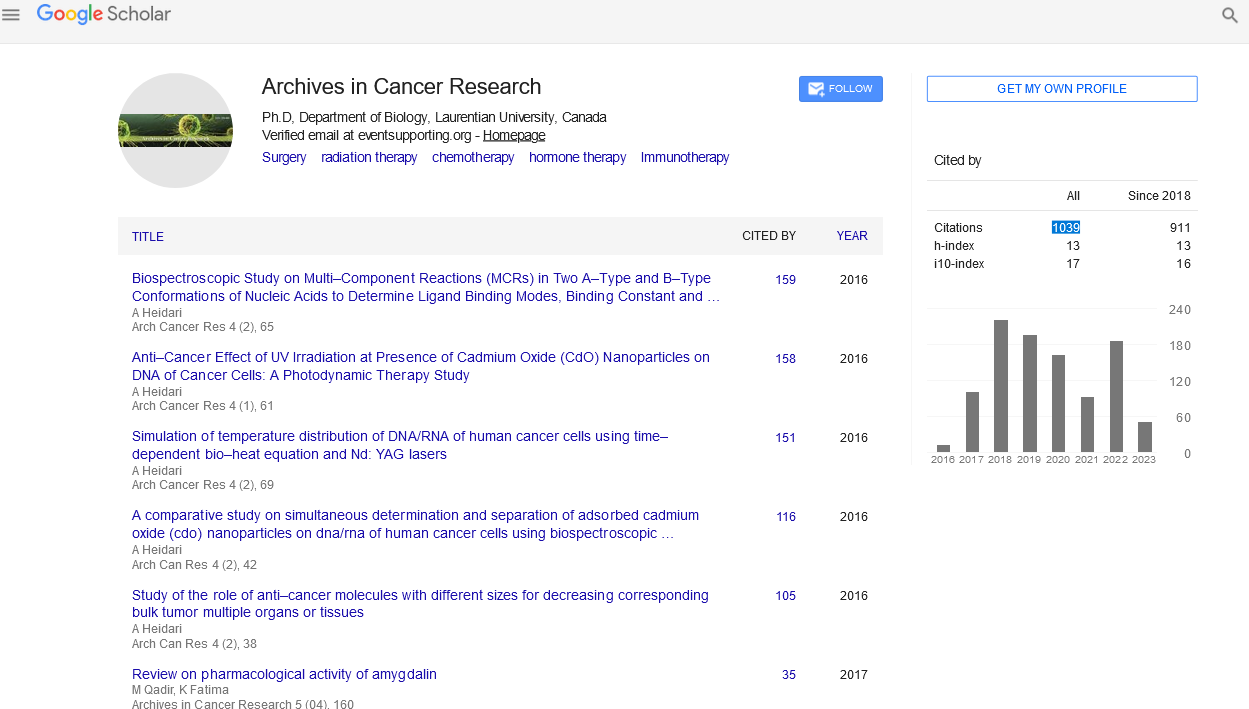Perspective - (2024) Volume 12, Issue 3
The Power of Data: Exploring Cancer Registry Archives
Kathleen Hicks*
Department of Oncology, Vanderbilt University, United States
*Correspondence:
Kathleen Hicks, Department of Oncology, Vanderbilt University,
United States,
Email:
Received: 15-May-2024, Manuscript No. IPACR-24-14893;
Editor assigned: 17-May-2024, Pre QC No. IPACR-24-14893 (PQ);
Reviewed: 31-May-2024, QC No. IPACR-24-14893;
Revised: 10-Jun-2024, Manuscript No. IPACR-24-14893 (R);
Published:
17-Jun-2024
Introduction
Cancer is a complex and multifaceted disease that affects
millions of people worldwide each year. In the battle against
cancer, information is key. Cancer registry archives serve as
invaluable repositories of data, providing insights into cancer
incidence, prevalence, trends, and outcomes. These archives
play a crucial role in cancer research, prevention, treatment, and
policy development. In this article, we delve into the significance
of cancer registry archives, their role in understanding the
burden of cancer, and their impact on improving patient care
and public health.
Description
Understanding cancer registry archives
Cancer registry archives are centralized databases that
systematically collect, store, and manage information about
cancer cases within a defined population. They contain detailed
data on patient demographics, tumor characteristics, diagnostic
procedures, treatments, and outcomes. Cancer registries may
cover specific geographic areas (e.g., countries, states, or
counties) or focus on specific populations (e.g., certain ethnic or
racial groups).
The importance of cancer registry archives
Epidemiological surveillance: Cancer registry archives provide
a comprehensive picture of cancer incidence and prevalence
within a population. By tracking the number and characteristics
of cancer cases over time, registries help identify trends,
patterns, and disparities in cancer occurrence, enabling public
health officials to develop targeted prevention and control
strategies.
Clinical research and treatment planning: Cancer registry
data are essential for clinical research and treatment planning.
Researchers use registry data to study the effectiveness of
cancer treatments, evaluate outcomes, and identify factors
associated with prognosis and survival. Clinicians rely on registry
data to make evidence-based decisions about patient care and
treatment options.
Cancer prevention and control: Understanding the distribution
of cancer within a population is critical for designing and
implementing effective prevention and control programs. Cancer
registry data help identify high-risk groups, assess the impact of
screening and prevention efforts, and guide resource allocation
for cancer prevention and early detection initiatives.
Quality improvement and benchmarking: Cancer registries
play a key role in quality improvement efforts within healthcare
systems. By benchmarking cancer care against national or
international standards, healthcare providers can identify areas
for improvement, implement best practices, and ultimately
improve patient outcomes.
Policy development and advocacy: Policymakers and advocates
use cancer registry data to inform policy decisions, allocate
funding, and advocate for cancer research, prevention, and
treatment programs. Registry data provide evidence of the burden
of cancer and the effectiveness of interventions, helping shape
public health policies at the local, national, and global levels.
Components of cancer registry data
Cancer registry data typically include the following components:
Patient demographics: Information about the patient's age,
sex, race/ethnicity, and other demographic characteristics.
Tumor characteristics: Details about the type, location, stage,
grade, and histology of the cancer.
Diagnostic and treatment information: Data on diagnostic
procedures, treatments received (e.g., surgery, chemotherapy,
radiation therapy), and follow-up care.
Survival and outcomes: Information on patient outcomes,
including survival time, recurrence, and cause of death.
Risk factors and comorbidities: Data on known risk factors for
cancer (e.g., smoking, family history) and other health conditions
that may impact cancer risk or prognosis.
Advancements in cancer registry archives
Integration of Electronic Health Records (EHRs): Many cancer
registries are now integrating data from Electronic Health Records
(EHRs) to enhance the completeness and accuracy of registry data.
This integration allows for real-time data capture, automatic data
extraction, and improved interoperability with other healthcare
systems.
Linkage with other data sources: Cancer registries are
increasingly linking their data with other sources, such as
mortality records, health insurance claims, and genetic
databases. This linkage enables researchers to conduct more
comprehensive analyses, explore new research questions, and
identify novel risk factors and biomarkers.
Population-based genomic profiling: Some cancer registries
are incorporating genomic profiling data into their databases to
better understand the genetic drivers of cancer and identify
targeted treatment options. Population-based genomic profiling
can provide insights into the molecular characteristics of tumors
and inform precision medicine approaches.
Data visualization and analysis tools: Advances in data
visualization and analysis tools are making it easier for
researchers, clinicians, and policymakers to explore and analyze
cancer registry data. Interactive dashboards, geospatial mapping
tools, and machine learning algorithms enable users to identify
trends, patterns, and disparities in cancer incidence and outcomes.
Challenges and considerations
While cancer registry archives offer tremendous benefits,
they also present several challenges and considerations:
Data quality and completeness: Ensuring the accuracy,
completeness, and consistency of registry data is essential for
maintaining the integrity of cancer surveillance efforts. Data
quality may vary depending on factors such as reporting
practices, coding standards, and data validation procedures.
Privacy and security: Protecting patient privacy and
confidentiality is a priority for cancer registries. Robust data
security measures and compliance with privacy regulations are
necessary to safeguard sensitive health information.
Data standardization and interoperability: Harmonizing data
standards and ensuring interoperability between different
cancer registries and healthcare systems is crucial for facilitating
data exchange, collaboration, and research across geographic
regions and organizational boundaries.
Resource constraints: Cancer registries may face resource
constraints, including funding limitations, staffing shortages, and
technological barriers. Adequate resources are needed to support
data collection, management, analysis, and dissemination
activities.
Future directions
The future of cancer registry archives lies in harnessing the
power of data to drive progress in cancer prevention, diagnosis,
and treatment. Key areas for future development include:
Enhanced data sharing and collaboration: Promoting data
sharing and collaboration among cancer registries, healthcare
systems, and research institutions can facilitate more
comprehensive and longitudinal analyses of cancer trends and
outcomes.
Precision oncology integration: Integrating genomic and
molecular data into cancer registry databases will enable more
personalized approaches to cancer prevention, screening, and
treatment, tailored to the individual characteristics of each
patient's tumor.
Real-time surveillance and monitoring: Leveraging advances
in data analytics and real-time data capture can enable more
timely surveillance of cancer trends, allowing for rapid detection
of emerging patterns and early intervention efforts.
Patient-centered outcomes research: Engaging patients and
caregivers in the design and conduct of cancer registry research
can ensure that registry data reflect the priorities and
perspectives of those affected by cancer and lead to more
patient-centered outcomes.
Conclusion
Cancer registry archives are indispensable tools in the fight
against cancer, providing critical insights into the burden of
disease, patterns of care, and outcomes for cancer patients. By
capturing comprehensive data on cancer incidence, treatment,
and outcomes, registries support research, inform policy, and
guide clinical practice, ultimately improving the lives of cancer
patients and their families. As cancer registry archives continue
to evolve and innovate, they will remain essential resources for
advancing our understanding of cancer and driving progress
toward a future where cancer is preventable, treatable, and
ultimately curable.
Citation: Hicks K (2024) The Power of Data: Exploring Cancer Registry Archives. Archives Can Res Vol:12 No:3





